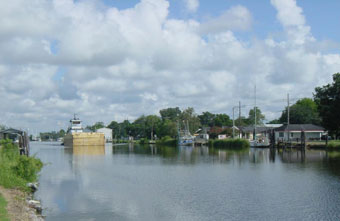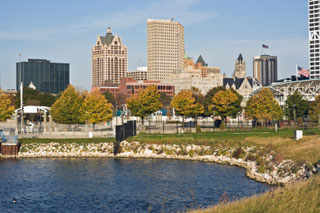CH2M HILL: Art of Sustainable Engineering
Sustainability is a complicated tongue-twister: six syllables long with myriad definitions. The term is frequently criticized just for that – being too lengthy, too complicated, too much trouble to type without the help of spell check. But when it comes to engineering and design, the word fits. No one-syllable specialty – no one simple answer – creates a sustainable solution. A project manager might have to find six specialties, or six different interest groups, to create a solution that fits those six syllables and lasts seven generations, which is one goal of sustainability’s many definitions. For CH2M HILL, sustainability is in the math. It’s about turning aspirations into hard business metrics.
The benefits of taking a multidisciplinary, multi-stakeholder approach to sustainable engineering design can be enormous. From saving $63,000 per year on energy costs in just one Army Aviation Support Facility in Colorado to creating 1,200 jobs from a former industrial brownfield in Wisconsin to powering an industry with waste landfill gas, doing the right thing for the future often translates to doing right by the bottom line. In coastal Louisiana, restoring wetlands provides a future, period. About 300,000 residents depend on successful ecosystem restoration to protect fresh water supply, to provide storm protection and to maintain their way of life.
To create the best solutions, it takes a fresh dedication to tearing down barriers among specialists and to forging new partnerships among technologists and within communities. It also means implementing sustainability principles into each step of a project’s life cycle—from siting to operation. CH2M HILL begins this process by understanding the community and ecosystem that every project inhabits and by breaking down its own barriers among technical disciplines to foster a creative environment. Innovation follows, thus enabling effective relationships with customers and their communities to build green projects that create jobs and redefine how our organization thinks about industrial and facility processes.
Knowing Your Place: Quantifying Ecosystem Benefits in a Complex Watershed
To plan the future, one must first know what, exactly, is at stake in the equation. CH2M HILL was founded by water treatment engineers. Our organization knows the cost of clean water processed by a treatment facility, as well as the treatment cost before it re-enters a watershed. What CH2M HILL didn’t know was how much clean water is worth in the first place – before urban development – and whether one could use that knowledge to proactively guide planning and development when pressure to grow is high.
The City of Damascus, Oregon, was included in the Portland Metropolitan Urban Growth Boundary in 2002 and incorporated in 2004. This previously rural area, which is expected to grow from 10,000 to 60,000 residents, is faced with significant infrastructure challenges and opportunities as they develop plans for a new urban city for the next 50 years. As the city is poised at the headwaters of all or part of eight different watersheds, responsible and sustainable land development decisions need to focus on preserving public services such as flood control, water quality protection, erosion control and carbon sequestration provided by exiting natural resources. Ecosystem service valuation, which allows the city to identify, assess and quantify natural resource ecosystem services, is the pathway for developing an equitable system to manage these resources while respecting private property rights

© iStockphoto.com/nwbob
Working under a grant from the Oregon Department of Land Conservation and Development, the City of Damascus and CH2M HILL developed and applied a new ecosystem services assessment method. The result of the evaluation was a database and map of existing ecosystems and their aggregate values. This tool is used to calculate ecosystem service gains and losses resulting from development actions. From there, the City was able to identify specific locations where services of stormwater, water quality and wildlife function are best provided. The framework for managing these lands is currently under development and will likely include regulatory, incentive and market-based tools for managing and improving the existing ecosystem service areas, many of which are located on private property.The need to proactively manage watersheds was clearly demonstrated in the valuation.
Using proprietary software, CH2M HILL is developing a water resource management decision support system to guide policy development. Modeling and water balance analyses will be conducted to establish integrated water resources system behavior for each watershed in Damascus. This integrated plan will support and guide upcoming decisions on service providers and agreements, built water infrastructure systems, management and enhancement of natural water systems, goals and objectives for master planning, codes and ordinances, and development criteria and approvals.“It is anticipated that differences in water demand, regulatory limits on receiving waters, proximity to existing infrastructure and ecological considerations will all be captured. Truly balanced water management that includes these factors will result in development of cost-effective, watershed-specific solutions,” comments Dave Green, CH2M HILL’s project manager.
Discovering New Ideas: Multidisciplinary Creativity
When one brings diversity of thought, science, style, culture and engineering together in a focused environment, creativity and innovation can happen. Creating such an atmosphere is a deliberate art that breaks with the past. Traditional design and construction projects follow a linear path: architecture, engineering design, construction and occupancy and operation. Cross-pollination among architects, planners, scientists and engineers created an opportunity to map renewable energy sources and then match those sources with high-energy demand facilities. Presco Energy commissioned CH2M HILL’s IDC Architects to create the only known net zero industrial scale renewable power development. The new Star Peak Energy Center is a renewable energy park that will combine geothermal, solar, wind and energy storage on a single site. The center will be developed on 10,000 acres of land about 110 miles north of Reno, Nevada. The concept includes an industrial-scale renewable energy park that allows direct energy users to benefit from carbon-neutral and grid-independent power sources.

© iStockphoto.com/KeithBinns
This wasn’t something CH2M HILL architects could do by themselves, and it certainly wasn’t far enough along to be an engineering job. In order for architects and master planners to envision site development, scientists and engineers had to create the art of the possible through detailed calculations on energy requirements and availability. These disciplines don’t typically work at the same time. But to create something fresh, innovative and sustainable, it’s required.The site’s first development is expected to be a state-of-the-art data center powered by geothermal power produced onsite, thus providing power at a lower cost than could be purchased from the local utility. Other potential users include manufacturers of photovoltaic solar panels, algal biofuel producers, general agriculture and universities or national research laboratories with ongoing renewable energy programs. With the right mix, waste heat from one process could support other processes on the site. This is an example of sustainable energy development with a net export of renewable energy, local food production and the ability to support various forms of alternative transportation.
Understanding Human Needs: Community Collaboration
If multidisciplinary specialists working together can provide innovative solutions, then the opportunities must multiply when CH2M Hill reaches beyond its own company and customers to the community. Located along the Mississippi River, Bayou Lafourche was influential in the commercial and residential development of the surrounding area. When the river’s tributaries flooded, they delivered sediment that helped build the bayou’s marshes. However, as river navigation needs changed and greater flood control was required, the U.S. government began a program of changing the river system’s course with dams and levees in 1902. Changed land use patterns increased tidal intrusion in the bayou and diminished the supply of fresh water for more than 300,000 area residents.

© CH2M HILL
“Integrated services from our water resources and ecosystem management teams were critical to understanding the ecological system, hydraulics and conveyance in the restoration process. This combination of science and engineering provides the expertise to mimic and to support the physical and chemical processes that create these ecosystems,” explains Kathy Freas, CH2M HILL’s Water Business Group Global Service Team Director.
Whenever a water tap is opened, electric and gas meters whirl a little faster because the procurement, distribution and treatment of water are an energy-intensive process. As a matter of fact, it is one of the greatest energy consuming processes for some municipalities, which means that a byproduct of water use is greenhouse gas emissions. Water treatment and distribution consumes an average 890 kWh per acre foot while procurement can range anywhere from zero to 4,500 kWh per acre foot. The amount of greenhouse gas emissions depend on the energy generation source, with gas and fossil fuel based generation contributing the greatest amount.
Under contract to the Louisiana Department of Natural Resources, CH2M HILL’s New Orleans project team partnered with the Office of Coastal Protection and Restoration to design a system that will divert 650 to 1,300 million gallons of fresh water per day from the Mississippi River. Diverting river water into the bayou will reduce saltwater intrusion, help sustain marshes and provide additional potable water to residents.
“Time is of the essence to restore these systems before they are lost forever. Ecosystem restoration must occur in a much shorter period and with fewer resources than natural systems typically require. But the big question is, ‘How do we manage the water and resources for both people and the environment?’” comments Freas.
The bayou’s original position, or “footprint,” was much larger in 1902 at the damming of the bayou than it is today. Originally, community members were resistant to a plan that would allow the state to reclaim bayou land they believed to be privately owned. However, after a series of public meetings where research findings and costs and benefits to the community as a whole were discussed, the state was able to establish its rights to the bayou and gain support of the local community.
Building Green: Creating Jobs & Reviving Ecosystems
Some portions of Milwaukee, Wisconsin, were missing out on the economic opportunity of the early 2000s. One area, a property polluted by more than 125 years of industrial activity – building and servicing locomotive engines and cars – seemed to have no potential.
“Basically, we turned a blighted, desolate area into an economic and environmental benefit,” comments Rich Block, project manager for the Menomonee Valley Industrial Center project.
As the program manager, CH2M HILL provided environmental strategies, remediation services and design and construction management for a new, mixed-use industrial and recreational park in the Menomonee Valley. This industrial center combines ecological rejuvenation and recreational green space side-by-side with commercial site redevelopment. The centralized stormwater management system was key to the development, as it incorporated native plantings, optimized developed space, saved development start-up costs and resulted in a cleaner river. Neighbors and local school groups enjoy new recreational features including bike and walking trails, soccer fields, fishing areas and canoe ramps to access the cleaner river.
Economically, 950 jobs for nearby neighborhood workers are already associated with seven new industries that anchor this development with the potential for greater job creation as the site grows. The site has created an increase of more than $120 million in recreational, aesthetic and ecological value for the people of Milwaukee. The customer saved more the $15 million by successfully negotiating a first-of-its-kind onsite waste management plan with the site’s regulatory agencies. Value engineering, revenue streams for imported fill and reuse of materials such as glass, timber and brick that otherwise would have been sent to a landfill saved another $25 million.

© iStockphoto.com/benkrut
“The economic sustainability of this project is two-fold: first, through the analyses we performed, we forecast a long-term $120 million net benefit to the City of Milwaukee. New businesses have hired local employees and generated tax-based revenue – something this area hasn’t seen for decades. Second, through the economic forecasts and innovative stormwater management that foster environmental sustainability, the city leveraged the ability to obtain grant funds to support the project and to provide tax credits for future light industrial business,” Block explains.
Another customer, the Jenkins Brick Company in Montgomery, Alabama, had a vision for powering a manufacturing facility without the use of fossil fuels. Mike Jenkins, chief executive officer, contacted CH2M HILL about evaluating landfill gas as a source of fuel for a new plant. Our organization went to work evaluating over 300 existing landfills within the Jenkins’ eight-state search area. The best overall match appeared to be the Star Ridge Landfill in St. Clair County, Alabama. After verification of gas collection and supply statistics, Jenkins signed a contract in November 2004.The grand opening of Jenkins’ Jordan Plant in October 2006 heralded a first for a major U.S. manufacturer: a facility sited specifically to use nearby landfill gas as fuel. It also significantly changes the economic profile of this small town when the plant is operational. The average annual total compensation at the plant is $50,000 in a county where the per-capita income is less than $18,000 per year.“This plant, named for Mike Jenkins’ father, is believed to be the largest manufacturing facility ever built at one time for bricks. In working toward design capacity, it became the most efficient plant in the world,” comments Beth Vaughan, CH2M HILL’s project manager.
When the plant is operating, 40 percent of the brick plant’s energy needs are being met with landfill gas with 100 percent projected to be met as the landfill grows. The landfill is working with Jenkins to install additional wells to extract more landfill gas for use in the Jordan Plant. When the plant begins operating at 100 percent design capacity, the company’s energy use at its three plant locations will be reduced from 1,500 Btu per pound of brick to 700. The plant will significantly reduce greenhouse gas emissions from the landfill by 62,000 metric tons of carbon dioxide annually.
“The new plant uses landfill gas and provides new jobs in small-town Alabama. How’s that for sustainability in action?” asked Vaughan.
Greening the Military: Buckley Army Aviation Support Facility
In 2008, the U.S. Air Force awarded the Honor Award in the Sustainable Design category to the Army Aviation Support Facility at Buckley Air Force Base in Colorado. That same year, the U.S. Green Building Council certified the hangar as a LEED Silver facility. The 115,000-square-foot facility is home to six CH-47 Chinook and sixteen UH-60 Blackhawk helicopters. It also provides offices for 55 full-time and 400 active-duty Guard members working in the hangar.

© CH2M HILL
“Hangars have huge power demands and heating loads that seem to oppose LEED certification, but each discipline team member saw the opportunity to save energy and to improve the work place,” said CH2M HILL’s Ed Pieterick, the architect of record for the facility.The team used building information modeling tools to optimize structural, lighting and HVAC systems design and to ensure sustainability goals were met while staying within the client’s construction budget. The final design uses 42 percent less energy compared to traditional designs, thus saving nearly $60,000 annually. A number of innovations, including high-efficiency heat recovery, low-energy evaporative cooling and daylight harvesting technologies, work in tandem to achieve these savings. A state-of-the-art, Web-based monitoring and control system allows the facility manager to further maximize energy savings.More than 93 percent of construction waste was diverted from landfill. Additionally, 7,300 tons of existing asphalt and gravel were re-used, which saved up-front project costs and allowed investment in other technologies that reduce long-term operating costs. Xeriscaping and effective use of roof runoff reduce water consumption for irrigation by 70 percent. Potable water consumption is cut in half through the use of ultra-low-flow showers, sinks, toilets and waterless urinals.
Understanding the Bottom Line

© iStockphoto.com/ZargonDesign
The primary definition of the word “art” implies a human effort to imitate, supplement or alter the work of nature. CH2M HILL, however, works diligently every day to define the word, and its practice, as a conscious production or arrangement within a system of principles and methods that transform the mundane and unimagined into a process of creative expression and aspirations for sustainable development. These aspirations are partnered with nature, not apart from nature, and include hard business metrics to empower humanity not just for today, but for many generations to come. CH2M HILL’s art of sustainable engineering is more than a business model or formulation; it’s the byproduct of the hearts of its 23,500 employees.





























